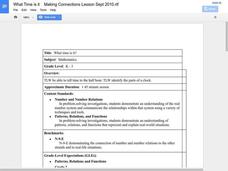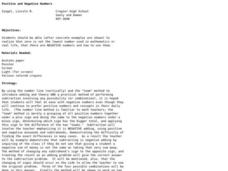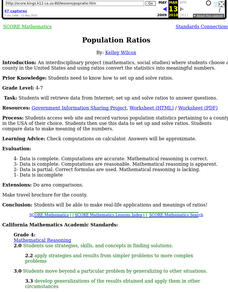Curated OER
The Seasons of the Year Expressed in Art
Students explore a variety of works of art to discover the relationships and common themes that connect math, science, and technology. Several pieces of the work of Thomas Cole are examined and linked to the four seasons.
Curated OER
Picture the Problem
Students create an illustration of how to solve math problems. They use appropriate resources for solving the problems. Students have to demonstrate how drawing diagrams and using pictures can help them by using KidPix. On Slide One,...
Curated OER
What Time is It?
Students explore time by completing worksheets. In this time-telling lesson plan, students utilize images of clocks and determine what time they read. Students answer more clock questions with a Smart Board and complete a clock worksheet...
Curated OER
Location, Location
Third graders draw and interpret simple scale maps, use maps to move around efficiently or plans to propose actions. They use of a compass to specify and find directions. They display and discuss a map of the local region.
Curated OER
Angles Lesson Plan
Young scholars stud angles, and then play the "What's Your Angle?" game. They complete at least 10 computer generated problems from the Angles Applet.
Curated OER
What's A Problem?
Fifth graders utilize strategies to solve a variety of problems and create problems of their own. They write explanations of problem solutions and using a checklist, evaluate themselves.
Curated OER
Regrouping With Remediation
Fourth graders complete multiplication, addition, and subtraction problems that all contain regrouping. In this regrouping lesson plan, 4th graders complete worksheets not provided.
Curated OER
Black Bayou Lake Measures Up
Students, in groups, estimate measurments and then select the tools needed and measure various items at Black Bayou Lake refuge.
Curated OER
Area Lesson Plan
Students manipulate a variety of materials and computer applets in order to explore area and the units used to measure it.
Curated OER
Positive and Negative Numbers
Students discover negative numbers and how to use them by using the number line and the "team" method.
Curated OER
What's Below Zero?
Pupils examine the concept of positive and negative integers, adding and subtracting integers on a number line. They visit various Internet websites, solving problems using integers and completing a worksheet.
Curated OER
Map Studies - Estimate And Measure Distance
First graders explore estimating and measuring distances. They analyze and discuss a map of New York State, make estimations, measure distances using yarn, and calculate total distances between cities on the map.
Curated OER
Angle Attributes and Measures
Seventh graders explore the concept of angles. In this angles lesson, 7th graders use protractors to measure angles. Students sing an angle song. Students discuss attributes of angles using a two-color plate manipulative.
Curated OER
Measurement, Perimeter and Area
Learners explore the concept of measurement. In this measurement instructional activity, students collect data about themselves such as height, finger length, neck circumference, foot length, and other body measurements. Learners cut...
Curated OER
M&M Exponential Activity
Students create a scatter plot of their experimental data. In this algebra lesson, students use M&M's to determine an algebraic model. They discuss results in class.
Curated OER
"it's All in the Cellar"
Seventh graders examine the process of constructing a site plan map at archaeological sites. They discuss the process of mapping techniques and calculation of percentages, create a plan site map of a cellar at Jamestown, and calculate...
Curated OER
Making a Brain: Aritifical Neural Network
Students explore how the brain works. In this nervous system lesson, students create a network of "neurons" to simulate how the nervous system and the brain work together.
Curated OER
At Home on the French Frontier: 1700-1800
Students role play bartering for goods and services as the French settlers did in colonial Illinois. They start with eight household items to acquire through bartering. They have to calculate values for each object and determine the...
Curated OER
"Is a Blue Whale the Biggest Thing There Is?" by Robert Wells
Young scholars discuss how big is big. They compare the area and perimeter of an acre and a football field.
Curated OER
Bar Me In
Fourth graders watch a video about constructing bar graphs. They create their own graph and interpret it.
Curated OER
A Day at the Beach
Student read Sheryl Wilson's story, "A Day at the Beach" while classifying items they find. They design a chart of the items before using educational graphing software to create a graph.
Curated OER
Not Everything Is More Expensive
Students investigate the concept of using different types of presentations to help solve mathematical problems. They research the use of illustrations to help understand data and its interpretation in a graphing format. Students also...
Curated OER
Population Ratios
Students access web site and record various population statistics pertaining to a county in the USA of their choice. They use this data to set up and solve ratios. They compare data to make meaning of the numbers.

























